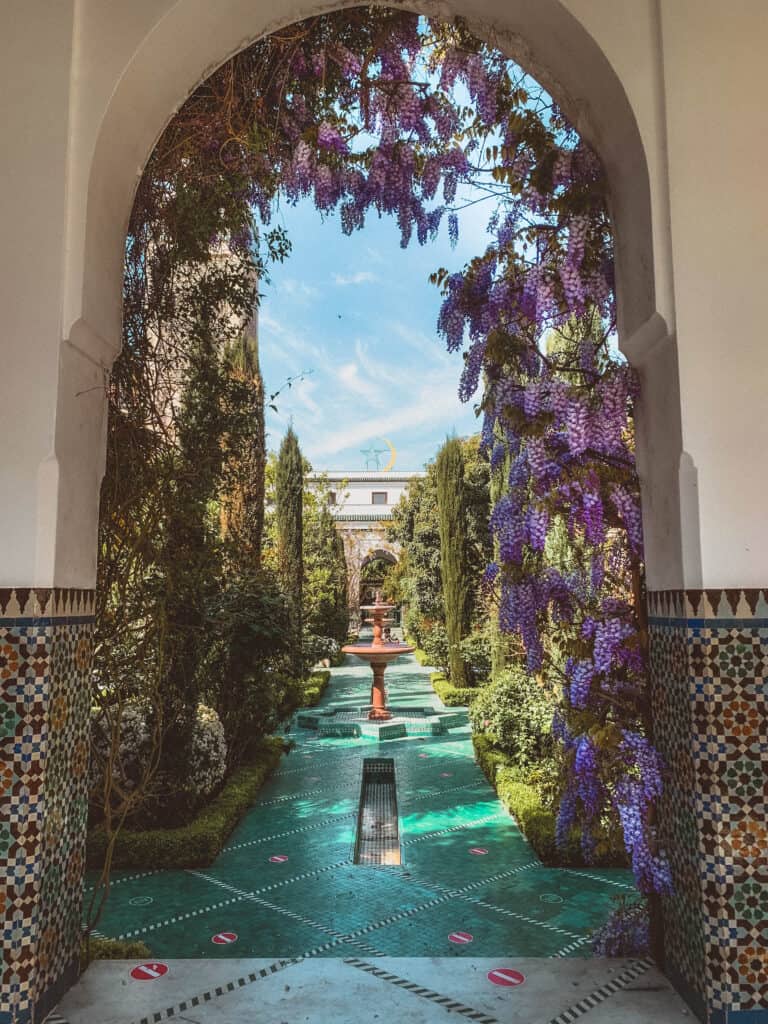How to Visit the Grande Mosquée de Paris (Paris Mosque)
Last Updated on 13th September 2021 by Sophie Nadeau
This post may contain affiliate links. Please check out my privacy policy and disclosure for more information.
Situated in the 5th arrondissement (the Latin Quarter) of Paris, the Grande Mosquée de Paris is one of the largest Mosques in France and dates back close to a century. Here’s a history of the Paris Mosque, which is also known as the Grand Mosque of Paris, as well as how to visit (and where you can see some of the most beautiful wisteria in the entirety of the French capital).

As well as prayer rooms, a library, gift shop, restaurant and café, and Hammam, there’s a beautiful central courtyard featuring mosaic walls, a turquoise tiled floor that resembles flowing crystal clear water, and stunning gardens that are best seen during the spring and summer.
Unless you’re visiting during wisteria season (more on this later), then it’s worth noting that the Mosque is a tranquil and peaceful place which is largely devoid of visitors in comparison with some of the other major attractions that Paris has to offer. All in all, if you’re looking for a unique and hidden gem of Paris, then you simply cannot miss out on a visit to the Mosque.
Contents
A history of the Grande Mosquée de Paris
The Grand Mosque of Paris was constructed in the 1920s (and completed in 1926) so as to honour French Muslim soldiers who fought in WWI. Over 100,000 soldiers of Muslim faith fought and died for France from 1914-1918.
Today there is a plaque which honours the soldiers who fought for France in WWII at the far end of the internal courtyard furthest from the entrance.The Mosque itself was constructed in the Moorish architectural style, a type of architecture which largely originates from Morocco and Spain.
Specific architectural features include horseshoe arches and mosaic tiling on both the walls and floor.The materials are the same ones which would be used in other traditional Moorish architecture.
Of particular note are the tiled and intricate fountains which are often filled with water during the summer months of the year. Prior to the construction of the Mosque, there was no Mosque in Paris and Muslim worshippers were denied the rights to construct one by the City of Paris. In 1926 the Mosque was inaugurated. But that is not the only world war which had a great impact on the Mosque and its community of worshippers.
The Grand Mosque of Paris during WWII
During the Nazi occupation of Paris during WWII, during which the Nazis set up headquarters in Hôtel de la Marine on Place de la Concorde, the Grand Mosque became a prime place of French Resistance.
The rector of the Mosque, Abdelkader Ben Ghabrit, and he did heroic work in saving hundreds of Jewish people from the Nazi. To the outside world, Abdelkader Ben Ghabrit appeared friendly towards the Nazis. However, within the walls of the Mosque itself, he was secretly helping, hiding, and housing hundreds of Jewish people. He saved at least 500 people. Abdelkader Ben Ghabrit made use of the Paris catacombs (former clay quarries which run all under the city) in order to hide people. He also made fake Muslim birth certificates in order to aid Jewish people in hiding from the Nazis.
One of the prime examples that show the great lengths to which Abdelkader Ben Ghabrit went to ensure the safety of the Jewish people he was helping was the case of Salim Halali, a famous singer of Jewish ancestry.
In order to fake Muslim ancestry, Abdelkader Ben Ghabrit issued Halali with a fake Muslim birth certificate and even etched his late father’s name onto an unmarked grave in a Muslim cemetery in Bobigny. Today, the Mosque is the largest Muslim place of worship in Metropolitan France.
Things to see at the Grande Mosquée de Paris
Minaret
Presiding high above the rest of the Mosque complex, at 33 metres (over 100 foot) to be precise, you won’t be able to miss the Minaret. Unfortunately, due to safety concerns (the railing at the top of the tower is not high enough so as to pass French visiting standard), the viewing platform of the Minaret is closed to visitors.
Library of the Grand Mosque of Paris
One of the grandest and most impressive rooms of the Mosque which is open to the public is that of the library. The library has a beautiful wooden ceiling with lantern windows and wood panelled bookshelves which house thousands of books.
Wisteria at the Grand Mosque of Paris.
Of all the places to see wisteria in Paris, the Grand Mosque of Paris is easily one of the best spots in the city. After all, the tiled central courtyard is home to decades old vines which snake their way around the central area and smell simply delightful.
The wisteria at the Mosque of Paris tend to begin blooming from mid to late April and last for several weeks from around the beginning to the middle of May. In order to check whether or not the wisteria is currently in bloom, I highly recommend logging into Instagram and checking recent stories on the Mosque’s location so as to see whether the purple flowers (known as glycines in French) are currently in bloom or not.

How to visit the Grande Mosquée de Paris
You should know before visiting that there’s a €3 admission cost (€2 concession rate) to visit the Mosque. Every time I’ve visited, the card machine hasn’t been working and so I’ve had to pay with cash (so make sure to have some on you before making the trip as the nearest ATM machine is around a five minute walk away).
Be sure to wear clothing that covers your knees and shoulders. Photography is permitted in the central courtyard area and I recommend visiting earlier in the day and mid-week if possible (especially during wisteria season) as the place gets incredibly popular among professional and amateur photographers alike.
After visiting the Mosque, I highly recommend heading to the next door café and restaurant. A particular speciality of note is the mint tea for sale for €2 and the various sweet pastries (many of which are almond and pistachio based), which are also for sale for €2 each. There’s a little courtyard where you can sip and drink on your tea and eat your pastries or alternatively you can ask to get them to go in a takeaway box.

Enjoyed reading about how to visit the Grande Mosquée de Paris? Pin this article now, read it again later:








